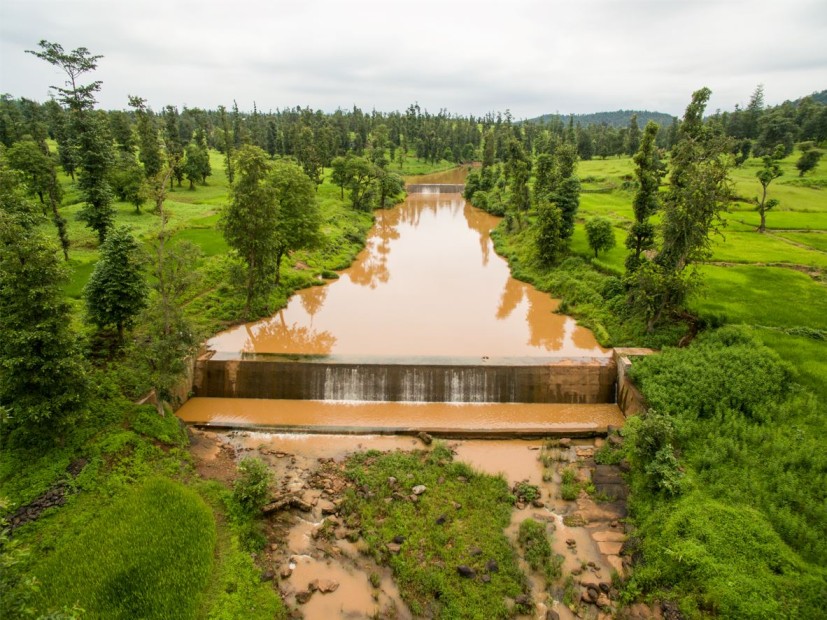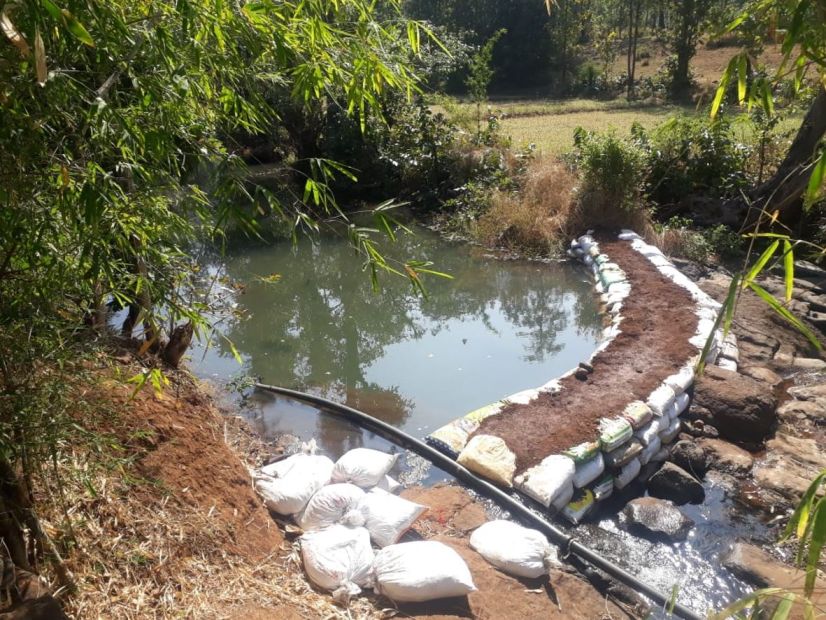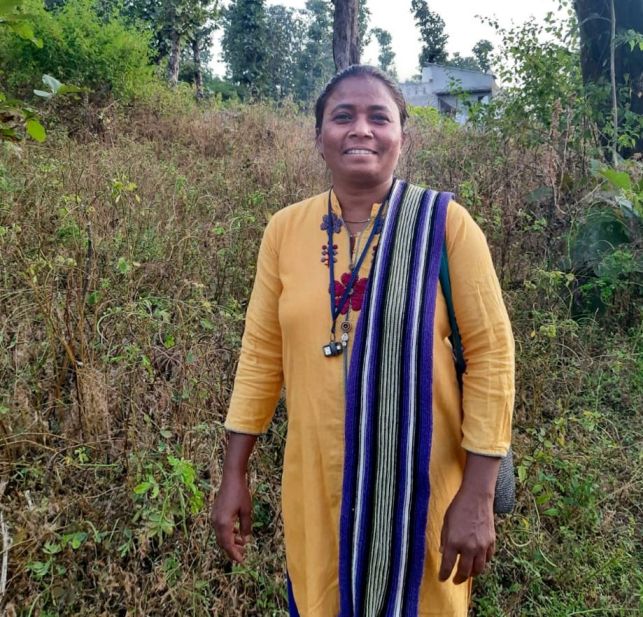Meet Gujarat’s ‘Water Champion’ Whose Innovations Help 230 Villages Conserve Water
Neeta Patel from Gujarat is hailed as a ‘water champion’ for her work on water conservation and women empowerment.

Conservation and efficient water management initiatives in the tribal hinterlands of Dang, Narmada and Bharuch— considered among the six economically distressed districts of Gujarat—has led to scores of water-stressed villages becoming water sufficient.
This is all thanks to the 12-year-long effort of Neeta Patel, now hailed as a ‘water champion’.
Patel’s work on water conservation and women empowerment has impacted the lives of over 30,000 inhabitants, spread across 51 villages in these districts and others residing in scores of villages in the southern part of Gujarat.
Every day Patel moves from village to village, traversing the hilly region on a two-wheeler, at times covering 80km to 90km, reaching out to distant Adivasi padas. Here, she mobilises thousands of women raises water-related issues with the Panchayats, erects water harvesting structures and sets up water committees.
Patel (42), a postgraduate in Rural Studies from New Delhi’s Shree Sant Kabir Training Institute encountered grinding poverty during her growing up years in Mograwadi village in Navsari but continued her studies thanks to the scholarships she earned and the unstinted support of her parents.
She recalls, “My family owns an acre of land on which we grew crops during the monsoon while my parents worked as farm labourers the rest of the year. My two brothers and I supplemented the household income doing odd jobs like cutting grass, harvesting sugarcane or picking mangoes, earning Rs 12 a day.”
Many times, the Patel kin borrowed clothes from their neighbours and, as they lacked footwear, worked barefoot in the fields.
Thanks to her good grades she was often rewarded with notebooks and stationery items. After Class 7, she used to walk 22km every day to the nearby village of Agasi to pursue further education. She says, “Those days school was my only solace.”
Having finished schooling Patel joined a residential college with food, uniform and books provided free. Her parents put together Rs 2,000 as a fee for the first year, however, in the succeeding years she won scholarships to complete her graduation from Surat’s Gandhi Vidhyapith Vedchhi. She says, “I briefly worked for a Navsari-based organisation and in 2002 joined the AKRSP (I) or Aga Khan Rural Support Programme (India), to work as a development organiser and was sent to Kambodiya village.”
Kambodiya in Valia Taluka of Bharuch District is a sparsely populated village of around 408 households and around 2,000 inhabitants. Having found that there was no facility for potable water, she assisted the villagers to draw out a plan to install water supply channels and submitted the same for the Panchayat’s approval. However, the Panchayat refused their plea.
For days together, then a 23-year-old, Patel persisted, mobilising the villagers and ultimately made the Panchayat yield resulting in 200 households receiving regular water supply. Till then, the local water committee had excluded women from being members but following the protests, the Panchayat gave up passing a resolution favouring them.
In another instance, the Sarpanch refused the village women of Kirli from installing a hand pump despite the funds coming from a Mahila Vikas Mandal. But persistent efforts of the locals and Patel led to the Panchayat consenting and the villagers becoming proud owners of a hand pump.
Tree Plantation Drives

Visiting the tribal hamlets, Patel realised that the hilly regions of Narmada and Bahruch were denuded any semblance of vegetation though it received plentiful rains between June and October. The water went downhill joining the rivers while the villagers experienced acute water stress. Mobilised by Patel, some 2,000 people took part in planting around 90,000 saplings which still stand and benefit the locals by providing fuelwood. “We did this on a total of 300 hectares between 1997 and 2000 with the support of the Forest Department,” says Patel.
Working for nearly 10 years Patel summoned villagers to build scores of check dams, group wells, trenches, check walls and erect boribundhs (bags filled with sand) on Purna, Khapri, Ambika, Gira and Dhodhad rivers flowing in Dang district.
Lift irrigation schemes that benefitted 400 families were introduced with the financial support of a couple of foundations, NGOs and voluntary labour from the villagers. “The check dams built by the State Government were in utter despair and served no purpose. We repaired 48 of them,” informs Patel.
In 2013, Patel, now a Cluster Manager with AKRSP, came across three villages in Subir Block in Dang district facing acute water stress as the check dams, built by the State government, needed urgent repairs. They were broken in several places.
Once the monsoon was over the check dams were empty. With resources provided by an Indian bank and shramdan of the villagers, the dams were repaired and presently fulfil the need of some 2,500 inhabitants.
Pani Samitis

Landholdings in Dang, Narmada and Bahruch villagers are very small, not exceeding 10 to 20 gunthas (40 gunthas or 40,400 sq ft makes an acre) per family and most practice farming only during the monsoon months while taking up menial jobs or migrating to cities in the rest months.
Here people used to walk 3km to 4km daily to fetch water. Villages like Amsarpada, Chikhali, Piplaidevi, Sabarpada, Zaran, Vadpada and Hindla, all in Dang district, witness severe water stress during March to June and water tankers are requisitioned to provide drinking water.
Though the district received good rainfall, being a hilly region the water flowed to the plains. This led to a drinking water crisis. “Some 15 years back, only 2 per cent of farmers took a winter crop but there are scores of them, all due to the efforts of the villagers,” informs Patel.
Patel’s efforts have turned many water-stressed villages into water sufficient ones and its visible impact is evident on both ground and surface-water availability. She involved women stakeholders as they often encountered the brunt of water shortage.
Patel’s effort has led to the setting up of ‘Pani Samitis’ run by women in several villages that works in coordination with the Panchayat for combating the water problems in the villages. In Dang, she has helped create four women empowerment groups with a total strength of 2,900 members.
Solar-run irrigation systems and other agricultural systems were developed by Neeta, which presently benefits close to 22,000 families, spread in 230 villages in Dang and irrigate 1000 hectares. A top to bottom water conservation approach’ was undertaken with many group wells, check dams being repaired and recharge structures constructed. Additionally, forest development work, soil treatment was undertaken through public participation. These efforts showed improvement with rising water levels in at least 25 villages with women running their drinking water schemes.
Patel attributes her success in water conservation activities to the unstinted support she received from the stakeholder — the tribals, many of whom were women. “It gives me immense joy and a feeling of satisfaction seeing how the women have been empowered and become their decision makers,” says Patel who was among 41 women from different parts of the country to have raised awareness around water and improved access to it and was honoured by the United Nations Development Program in India last year.

Edited by Yoshita Rao
If you found our stories insightful, informative, or even just enjoyable, we invite you to consider making a voluntary payment to support the work we do at The Better India. Your contribution helps us continue producing quality content that educates, inspires, and drives positive change.
Choose one of the payment options below for your contribution-
By paying for the stories you value, you directly contribute to sustaining our efforts focused on making a difference in the world. Together, let's ensure that impactful stories continue to be told and shared, enriching lives and communities alike.
Thank you for your support. Here are some frequently asked questions you might find helpful to know why you are contributing?


This story made me
-
97
-
121
-
89
-
167














